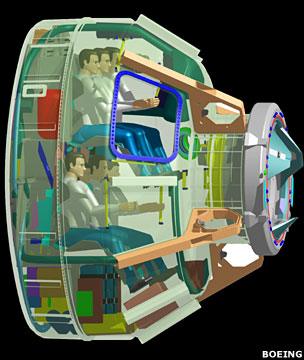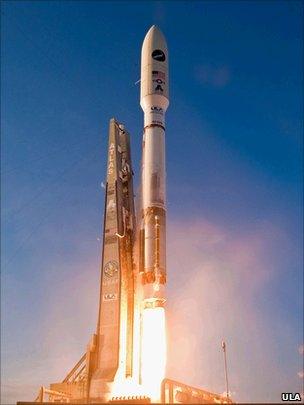Boeing pilots to make space trip
- Published

The CST-100 is Boeing's answer to Nasa's call for a commercial crew transport service
Boeing says two of its own employees will crew the first manned mission of its new astronaut capsule.
The US company has confirmed it will use the Atlas 5 rocket to test its CST-100 ship on three flights in 2015.
An unmanned capsule will be used on the first and second launches. On the third, Boeing test pilots will take the vessel to the space station.
The plan is dependent on a successful development programme and the availability of sufficient funding.
Boeing is one of a number of companies being encouraged by the US space agency (Nasa) to develop a commercially operated crew transport service to and from low-Earth orbit.
The idea is that Nasa and other space agencies around the world would buy seats in these vehicles to get their people to the international orbiting platform and other destinations that might one day include privately run space labs and hotels.
Last month, Nasa retired its space shuttles, partly on the grounds of cost - they were hugely expensive to maintain.
The agency believes that by handing operational responsibility to the commercial sector, the price of getting into low-Earth orbit can be reduced substantially.
It is giving Boeing financial support to help it develop the CST-100 ship.
The conical design will be capable of carrying up to seven individuals.
The choice of the Atlas 5 as the CST-100's launcher is not a major surprise. It has an excellent record - 27 flights with a 100% success rate.
It also happens to be operated by a company that is part-owned by Boeing called United Launch Alliance (ULA). However, Boeing says that relationship played no part in the decision to use Atlas; it was simply that Atlas was deemed the best rocket for the task.
"Our approach is to produce a reliable spacecraft built on existing simple systems and then integrate that with a proven launch vehicle, all focussed on putting in place a very safe system, one that will be reliable and that can be operational as soon as practical so that we can start flying US crew from US launch sites post the shuttle era," said John Elbon, vice president and programme manager of Boeing's Commercial Crew Programs.

The Atlas 5 has a 100% record of launch success
The year 2015 will see the Atlas launch the capsule three times.
The first flight will put the ship in orbit. The second will take the CST-100 part-way towards space before practising an abort.
In this procedure, the capsule will push itself away from the rocket mid-flight as if there were some problem on the rocket. This will be a critical test of astronaut safety features built into the capsule in the event of an emergency.
Assuming these demonstration flights go well, the third mission will see Boeing test pilots take the CST-100 all the way to the International Space Station.
The CST-100 would then be ready for commercial service starting in 2016.
Boeing says the two pilots it plans to use on the manned mission in 2015 will emerge from a selection process that is already under way.
"We're actually interviewing now for the first one," said Mr Elbon. "I would like to get one on board so that they can be part of the design process and influence it from an operator's perspective."
The decision of Boeing to use the Atlas 5 follows hard on the heels of a recent agreement signed between Nasa and ULA to prepare the Atlas rocket for astronaut launch duties.
This work will determine which components on the Atlas already meet Nasa's stringent requirements for human spaceflight and which elements might need to be upgraded.
ULA is also developing an emergency detection system that would be placed inside the Atlas to give warning of a major malfunction. In addition, ULA needs to prepare a gantry structure that would allow astronauts to get in and out of a capsule when it is mounted on top of an Atlas at its launch pad.
"ULA will provide launch services from Space Launch Complex 41 at Cape Canaveral Air Force Station," explained George Sowers, ULA's vice president of business development.
"We will use the Atlas 412 configuration, which means it has a single solid rocket booster [attached to its liquid-fuelled core stage] and a dual engine Centaur upper stage.
"We believe the Atlas 5 provides the earliest possible initial launch capability for commercial crew and we'll be ready to support Boeing with both un-crewed and crewed test flights in 2015."
- Published18 July 2011